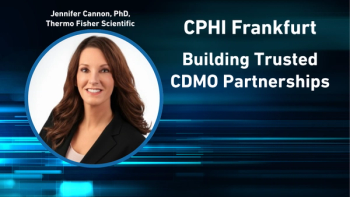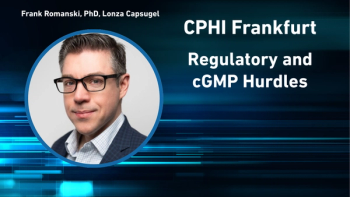
- Pharmaceutical Technology-04-02-2020
- Volume 44
- Issue 4
Being Vigilant in Supplier Oversight
Risk assessments, audits, and good communication between sponsor and supplier are key elements of supplier oversight.
The bio/pharmaceutical industry is a global network that ties together an array of developers, manufacturers, and suppliers. Bio/pharmaceutical companies, therefore, may source APIs and excipients from companies thousands of miles away. This global aspect of the industry, naturally, creates a complex supply chain that could leave patients vulnerable if not properly overseen. The discovery of nitrosamine impurities, including N-nitrosodimethylamine (NDMA) and N-nitrosodiethylamine (NDEA), found in angiotensin II receptor blocker (ARB) medicines (1) in 2018 is an example of how ingredient issues can affect patients and the supply chain and the importance of testing ingredients. Now, the global COVID-19 coronavirus pandemic has the potential to disrupt supply chains, site inspections, and other activities associated with supplier qualification and oversight.
Sponsor companies and manufacturers are responsible for ensuring the components they use are safe and effective. FDA has cited companies for failing to test their incoming API and raw materials “to determine their identity, purity, strength, and other appropriate quality attributes” (2). According to a spokesperson for IPEC-Americas, sponsor companies must verify the quality of materials, which includes qualification of the supplier through on-site good manufacturing practice (GMP) audits and/or a third-party GMP certification. Incoming materials should have their identification verified and the quality department should give its approval to release the materials for use. This includes performing-at a minimum-an identification test, and may include other tests necessary to ensure the quality for the intended use as per 21 Code of Federal Regulations 211.84(d)), advises IPEC-Americas.
Risk assessments of both suppliers and materials should also be performed, according to IPEC-Americas, with a specific focus on the intended use of the material. The risk assessment should also evaluate possible concerns with efficacy, variability, safety, and quality. And this evaluation should not end with the risk assessment. The sponsor should “[establish] a process for continued monitoring of the supplier and the quality of incoming materials,” according to IPEC-Americas.
Qualifying suppliers
How do sponsor companies choose and monitor material suppliers to ensure the ingredients they are purchasing are fit for purpose? Linda Evans O’Connor, vice president and chief of staff at Lachman Consultant Services, Inc., suggests that sponsors start by obtaining information from the supplier about its capabilities and compliance history through a questionnaire. Material samples should also be obtained to determine if they are fit for their intended purpose. Site audits should be performed, and quality agreements should be put in place, she says. Finished product trials should be performed if the materials meet the requirements. Batches should then be tested for stability. Periodic monitoring of the supplier should be performed with data reviewed on a predefined basis in addition to performing surveillance audits, according to O’Connor. IPEC-Americas stresses, however, that an appropriate risk assessment cannot be performed without onsite audit information.
Susan J. Schniepp, executive vice-president of post-approval pharma and distinguished fellow, Regulatory Compliance Associates, says that companies should begin the qualification with an onsite audit. “Once the audit is performed and any identified concerns resolved, the two parties, purchaser and supplier, can enter into a quality agreement. After the quality agreement is approved, the purchasing company can start the process of ‘qualifying’ the supplier. This qualification usually involves testing of the material to confirm the supplier’s certificate of analysis (CoA) is accurate and develop a history that demonstrates the ability of the supplier to continually provide a suitable product,” says Schniepp.
The supplier should then be placed on an approved supplier list, according to Schniepp. “The initial qualification for a supplier to be considered an approved supplier usually involves complete confirmatory testing on the first 10 lots of material received and then a periodic check and confirmation by the purchaser of the entire testing regimen listed on the CoA received from the supplier.”
Performing audits
Performing audits of material suppliers is key for ensuring the quality of materials, but how often should these audits be performed? O’Connor suggests that a risk-based approach should be used to determine when and how often a supplier is audited. “Many factors can go into the risk model, such as type of material (e.g., API, excipient, sterile, non-sterile, complex dosage form, etc.), location, past regulatory or audit history, recalls, quality of incoming goods, complaint history, importance to the business of the materials (i.e., Is this an API for your blockbuster drug and lack of supply would have a material impact on the business?). A minimum frequency per material type should be defined (i.e., for an API, every two years),” O’Connor says.
IPEC-Americas agrees. “Whether the supplier is an excipient manufacturer, contract manufacturer, distributor, or service provider (e.g., a contract testing lab), the initial audit frequency should be based on results from the initial supplier/excipient risk assessment along with any additional mitigation measures identified. Based on on-going monitoring, a sponsor company should determine whether to adjust the audit frequency.”
A quality risk management plan is key, agrees Schniepp. Frequency of audits should be based on the criticality of the material and the past performance of the supplier. “This plan should identify supplier vulnerability (i.e., single source, secondary supplier, etc.), which should help determine audit frequency. The quality agreement should reflect the risk plan but there should always be a contingency to allow for-cause audits as needed. Laboratories used by either the supplier or the purchaser should be audited and included as an element of the risk plan,” says Schniepp.
Auditing under difficult circumstances. Having a consistent and properly executed audit program is paramount to maintaining the timeliness and integrity of the supply chain, says Schniepp. Audits, and the information obtained during them, allow one to assess a supplier’s risk, especially during crises such as the COVID-19 pandemic. “Having the baseline knowledge of your suppliers’ operations will help assess where critical resources need to be allocated during a crisis period. While not ideal, audits can still be performed on suppliers through the use of questionnaires and video conferencing. If visuals are required for the supplier assessment, the use of an electronic device or video streaming options could be employed. Bottom line, to keep the supply chain viable during crisis mode we need to think outside of our normal operating procedures and experiences,” says Schniepp.
If travel is limited due to global situations such as the COVID-19 epidemic, O’Connor suggests getting creative. “For example, performing a virtual audit, while not ideal, is a possibility, and would require cooperation of the sponsor and the manufacturer. Document review and interviews can be performed remotely. Companies could even look at virtual facility tours using appropriate technology. However, these types of audits are not ideal, and shouldn’t replace on-site audits. Another solution is to partner with a local company that has the local resources to perform the on-site portion of the audit. This will allow on-site audits to occur even when international travel bans are in effect,” says O’Connor.
The role of CoAs
CoAs provide manufacturers with detailed information about materials including material manufacturer, quality testing information, specifications, batch numbers, and other information (3). FDA has been known to cite companies for incomplete or incorrect information on CoAs (4). So, how reliable are these documents and how much emphasis should sponsors put on them when it comes to ensuring material quality?
O’Connor suggests that sponsor companies create a library of CoAs or labels so they can verify that the information is correct. “Also, maintaining a relationship with suppliers is key. Anything unusual needs to be flagged,” says O’Connor.
Building trust between the sponsor and supplier is important, agrees IPEC-Americas. “A robust supplier qualification program, including an onsite GMP assessment of a supplier, by either the sponsor or a qualified third party, and development of a partnership with the excipient supplier are necessary to establish and build trust in the validity of their CoA.”
Annual confirmation testing of CoA results is also necessary, says IPEC-Americas (5). “Full testing of an excipient is required until a robust supplier study has been completed and a reduced testing program has been approved. Only once trust has been established can the sponsor move to a reduced testing program. However, identification testing is always required to ensure the identity of incoming materials.”
To establish that the quality testing information included in the CoA is accurate, incoming materials must be tested against the requirements in the CoA, Schniepp insists. “The best way to ensure the CoA is accurate is through complete testing. In cases of falsification of the CoA, results testing is mandatory to make sure the material is suitable for use; however, it must be coupled with a review of the supplier’s overall quality system. Even if the material meets the testing qualifications listed on the CoA, it may not be suitable for use due to other potential GMP violations that might be present at the supplier facility,” she says.
“In the case of falsification, the purchaser should be concerned with data integrity issues that lead to the falsification in the first place. If a purchaser suspects a supplier is falsifying the results on a CoA they need to initiate a for-cause audit and quarantine the suspect material until they can confirm it was satisfactorily manufactured following cGMP expectations. Passing test results does not confirm compliance to cGMPs,” Schniepp explains.
The role of CMOs
Many drug sponsors engage contract manufacturing organizations (CMOs) to conduct drug production steps. So, what is the CMO’s responsibility in ensuring that materials are safe and effective?
O’Connor says that while both sponsors and CMOs share responsibilities, the sponsor has the “ultimate” responsibility of its supply chain. “Sponsors and CMOs share responsibilities, but the selection, qualification, and oversight of suppliers is the sponsor’s responsibility, whereas day-to-day testing is generally the CMOs/CDMOs, although sometimes that goes to the sponsor as well. The sponsor has ultimate responsibility for the entire supply chain, so even if it delegates part of that responsibility to the CMO/CDMO, it is ultimately responsible.”
Sponsors must ensure that they have signed agreements in place with any CMOs and/or CDMOs they are using that identifies the responsibilities of each party when it comes to ensure the quality of materials, according to a spokesperson for IPEC-Americas.
Both sponsors and CMOs/CDMOs must have an active role, according to Schniepp. “The specific level of involvement of the sponsor may depend on the confidence they have in the CMO/CDMO organization. The CMO/CDMO should make sure they involve the sponsor in decisions involving material quality, so the sponsor is aware of the impact on their product,” says Schniepp.
Ensuring quality is about vigilance
Maintaining a safe supply chain is crucial in the bio/pharmaceutical industry. The efficacy and safety of the materials used in drug products is of utmost importance. And it is the sponsor’s responsibility to ensure the quality of all materials used in their products. Sponsors must not rely on others to ensure quality, says O’Connor. Also, not all suppliers should be treated the same. “Clearly, some suppliers have greater risk than others, either based on the product type, location, etc. These suppliers should receive more scrutiny,” she says. Sponsors also must not cut corners or do what is convenient, says O’Connor. For example, she notes, it is inconvenient, but necessary to audit suppliers in China and India. In addition, sponsors should also not make supplier decisions based on price or availability instead of quality and safety, says IPEC-Americas.
Communication is key to supplier oversight, says Schniepp. “Both parties need to be willing to talk as frequently as needed to address issues before they manifest into a disruption in the supply chain. The frequency of these conversations are not necessarily defined in a quality agreement. They are important in establishing an open relationship between the supplier and the purchaser so issues can be solved before supply chain disruption occurs. Not all problems can be solved through the terms included in the quality agreement and both parties must be willing to work outside the defined ‘communication schedule’ of the quality agreement to avoid unnecessary supply-chain interruptions.”
References
1. FDA, “FDA Statement on the FDA’s Ongoing Investigation into Valsartan and ARB Class Impurities and the Agency’s Steps to Address the Root Causes of the Safety Issues,” Press Release, Jan. 25, 2019.
2. FDA,
3. A. Shanley, Pharmaceutical Technology 42 (4) 60-69 (April 2018).
4. FDA,
5. FDA, 21 CFR 211.84(d), Title 21–Food And Drugs, Chapter I–Food And Drug Administration, Department Of Health And Human Services, Subchapter C–Drugs: General, April 1, 2019.
Article Details
Pharmaceutical Technology
Vol. 44, No. 4
April 2020
Pages: 72–76, 83
Citation
When referring to this article, please cite it as S. Haigney, "Being Vigilant in Supplier Oversight," Pharmaceutical Technology 44 (4) 2020.
Articles in this issue
over 5 years ago
Biosimilars Poised for Gains in US Marketover 5 years ago
Critical Knowledge for Preparing Auditsover 5 years ago
Can Vaccine Development Be Safely Accelerated?over 5 years ago
Supercritical Fluid Chromatography Systemover 5 years ago
Quaternary Diaphragm Pumpover 5 years ago
Custom-Built Heated Storage Vesselover 5 years ago
Well Plates and Cartridges for Liquid Extractionover 5 years ago
Alternative Cleaning Validation Methods for BiologicsNewsletter
Get the essential updates shaping the future of pharma manufacturing and compliance—subscribe today to Pharmaceutical Technology and never miss a breakthrough.





